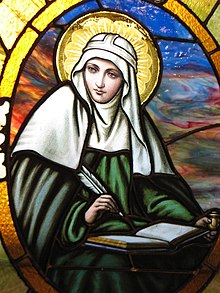
Back Heilige Afrikaans Heiliger ALS Sanct ANG قديس Arabic قديس ARZ Santu AST Müqəddəs Azerbaijani Santo BCL Святы Byelorussian Сьвяты BE-X-OLD

In Christian belief, a saint is a person who is recognized as having an exceptional degree of holiness, likeness, or closeness to God. However, the use of the term saint depends on the context and denomination. In Catholic, Eastern Orthodox, Anglican, Oriental Orthodox, and Lutheran doctrine, all of their faithful deceased in Heaven are considered to be saints, but some are considered worthy of greater honor or emulation.[1] Official ecclesiastical recognition, and consequently a public cult of veneration, is conferred on some denominational saints through the process of canonization in the Catholic Church or glorification in the Eastern Orthodox Church after their approval.[2][3]
While the English word saint originated in Christianity, historians of religion tend to use the appellation "in a more general way to refer to the state of special holiness that many religions attribute to certain people", referring to the Jewish ḥasīd or tzadik, the Islamic walī, the Hindu rishi or Sikh Bhagat and guru, the Shintoist kami, the Taoist shengren, and the Buddhist arhat or bodhisattva also as saints.[4][5] Depending on the religion, saints are recognized either by official ecclesiastical declaration, as in the Catholic faith, or by popular acclamation (see folk saint).[6]
- ^ Woodward, Kenneth L. (1996). Making Saints. Simon & Sachier. p. 16. ISBN 978-0-684-81530-5.
Among other Christian churches, the Russian Orthodox retains a vigorous devotion to the saints, especially the early church fathers and martyrs. On rare occasions, new names (usually monks or bishops) are grafted onto their traditional list of saints ... Something like the cult continues among Anglicans and Lutherans, who maintain feast days and calendars of saints. But while the Anglicans have no mechanism for recognizing new saints, the Lutherans from time to time do informally recommend new names (Da Hammarskjold, Dietrick Bonhoeffer, and Pope John XXIII are recent additions) for thanksgiving and remembrance by the faithful. The saint, then, is a familiar figure in all world religions. But only the Roman Catholic Church has a formal, continuous, and highly rationalized process for 'making' saints.
- ^ Bebis, George (n.d.). "The Lives of the Saints". Greek Orthodox Archdiocese of America. Retrieved 7 May 2016.
- ^ "The Glorification of the Saints in the Orthodox Church". www.oca.org. Retrieved 1 February 2024.
- ^ Jones, Lindsay, ed. (2005). "Sainthood". Thomson Gale Encyclopedia of Religion (2nd ed.). Macmillan. p. 8033.
Historians of religion have liberated the category of sainthood from its narrower Christian associations and have employed the term in a more general way to refer to the state of special holiness that many religions attribute to certain people. The Jewish ḥasīd or tsaddiq, the Muslim waliy, the Zoroastrian fravashi, the Hindu rsi or guru, the Buddhist arahant or bodhisattva, the Daoist shengren, the Shinto kami and others have all been referred to as saints.
- ^ Gustav, Mensching. "Saint – Encyclopedia Britannica". Encyclopedia Britannica. Retrieved 13 January 2020.
Shintō, the native Japanese religion, is concerned with the veneration of nature and with ancestor worship; it does not have saints according to the standards of ethical perfection or of exceptionally meritorious performance. According to Shintō belief, every person after his death becomes a kami, a supernatural being who continues to have a part in the life of the community, nation, and family. Good men become good and beneficial kamis, bad men become pernicious ones. Being elevated to the status of a divine being is not a privilege peculiar to those with saintly qualities, for evil men also become kamis. There are in Shintō, however, venerated mythical saints—such as Ōkuninushi ("Master of the Great Land") and Sukuma-Bikona (a dwarf deity)—who are considered to be the discoverers and patrons of medicine, magic, and the art of brewing rice.
- ^ Ben-Ami, Issachar (1998). Saint Veneration Among the Jews in Morocco. Wayne State University Press. p. 13. ISBN 978-0-8143-2198-0. Retrieved 7 September 2012.
Veneration of saints is a universal phenomenon. All monotheistic and polytheistic creeds contain something of its religious dimension ...
© MMXXIII Rich X Search. We shall prevail. All rights reserved. Rich X Search